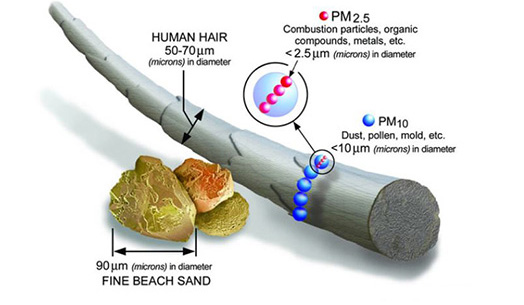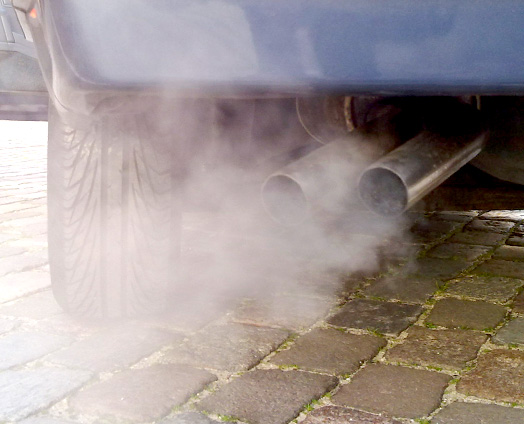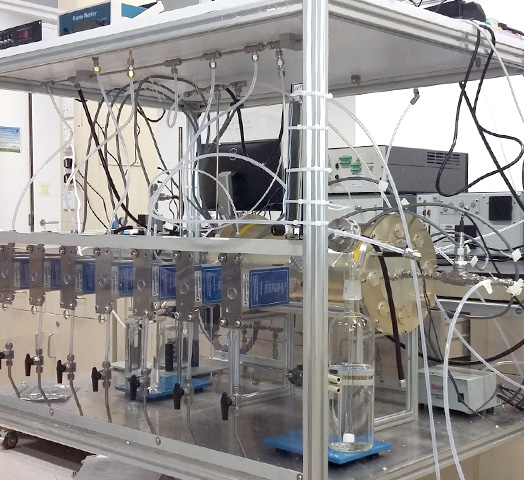
The Two Faces of Particulate Matter
Prof. Chan Man-nin
Earth System Science Programme
Air pollution is an important environmental issue in Hong Kong. Particulate matter (PM), e.g., PM2.5, is considered a major air pollutant. However, what are these small airborne particles and why do we care about them?
PM (also known as aerosols) is a mixture of solid particles and aqueous droplets suspended in the air. These particles vary greatly in size, composition, and sources. For example, some particles (e.g., mineral dust and pollens) are large and can be seen with our eyes. Some particles are too small to be seen. As shown in Figure 1, a PM2.5 is defined as a particle smaller than 2.5 micrometer in diameter and is only about one thirtieth of that of our hair. They can be seen under a microscope.


Ambient PM is a very complex mixture, containing inorganic salts, organic compounds, black carbon, trace metals, and varying amount of water. They originate from a number of sources. Some particles are emitted directly into the air from sources such as dust storm, volcanic eruption, sea spray, and biomass burning. Some particles are formed through chemical reactions in the air.
Once in the atmosphere, these tiny particles can have significant impacts on our health and climate. Many studies show that when the ambient PM concentration increases, the number of emergency room visits and hospital admissions for respiratory problems also increase. This is because increased concentration of PM and other air pollutants such as ozone can cause acute respiratory illnesses such as coughing, shortness of breath, and bronchitis. The elderly, children, and people with asthma, heart or respiratory diseases are at greater risk if they inhale these small particles. More recently, the International Agency for Research on Cancer has reported that increasing exposure to PM can increase the risk of getting lung cancer and has classified the PM as carcinogenic to humans.
PM is not only a potential threat to our health, but also plays a role in the climate. Depending on their composition, these small airborne particles can reflect and absorb radiation from the sun. For example, some particles (e.g., ammonium sulfate or organic compounds) may scatter the sunlight back to space. This reduces the amount of sunlight reaching the Earth’s surface and cools the air. On the other hand, some particles (e.g., black carbon or soot) can absorb the sunlight and warm up the air. PM is also needed for cloud formation as water molecules have to condense on preexisting particles and form cloud droplets. Like ambient particles, clouds can reflect some sunlight back to space and cool the air below them. In contrast to what greenhouse gases such as carbon dioxide and methane can do, climate model simulations suggest that PM and clouds can have a net cooling effect on the Earth's surface air temperature.
While PM can be a problem for air pollution, they can also help to cool the climate. Some scientists think that while a reduction in ambient PM concentration can improve air quality, it could exacerbate global warming. They argue that when there are fewer particles in the air, there would be less clouds. To date, the role of PM in cloud formation and climate change is still not fully understood. PM remains one of the largest uncertainties in the projection of future climate change.


My research team focuses on investigating the formation mechanisms of ambient PM in order to better understand the role of PM in ambient air quality, and climate change. We have constructed in the laboratory a reactor to simulate PM formation (Figure 2). We also measure the climate-related properties of PM such as heterogeneous reactivity, light scattering and absorption, and water uptake. Results obtained from our laboratory studies will be incorporated into air quality and climate models and will be used to improve, refine and evaluate the performance of the models.


